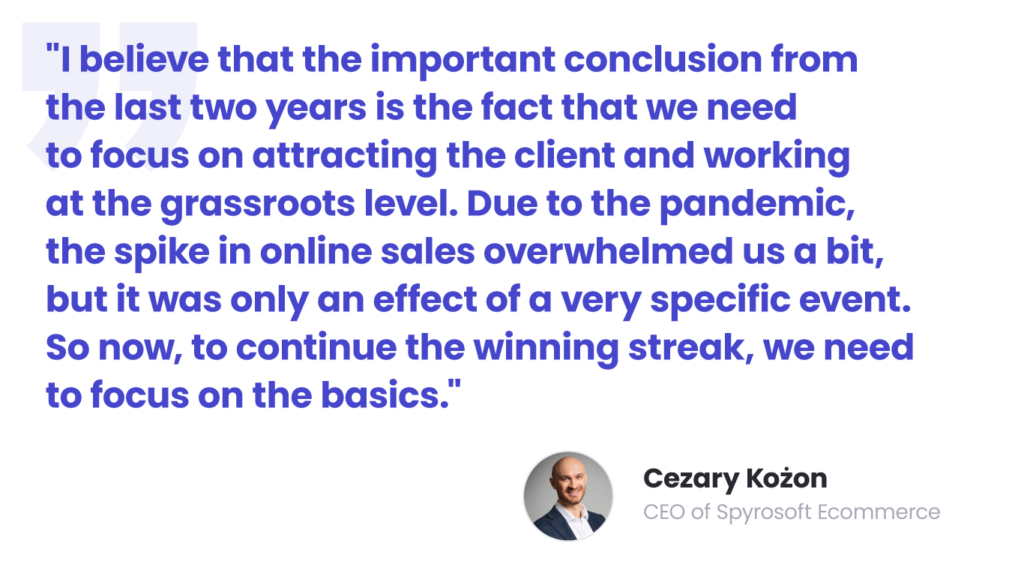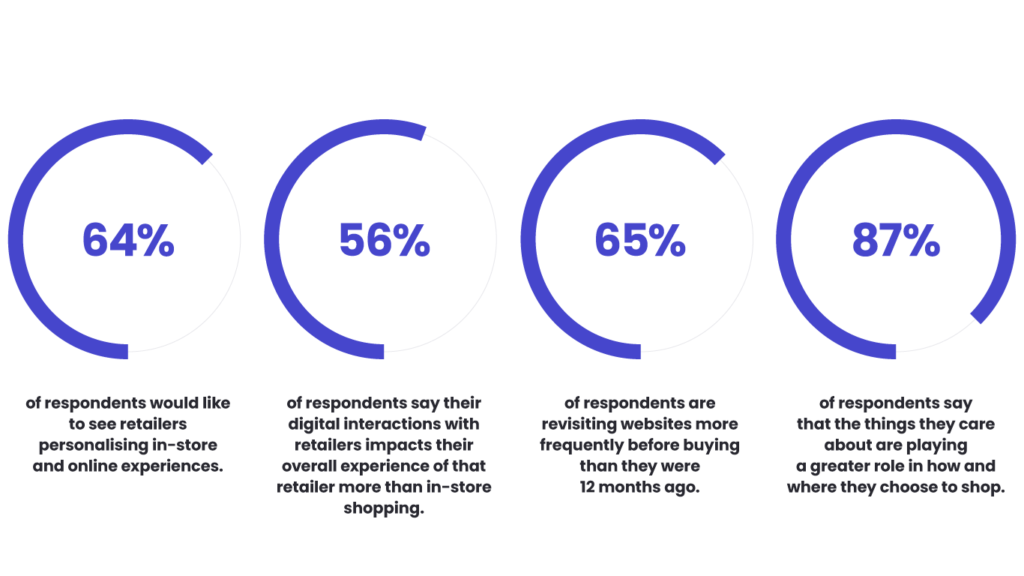Combining online and offline channels is key for ecommerce market sales
The ecommerce market is full of challenges, especially since crises such as the pandemic or the war in Ukraine affect the entire economy as well as consumer behaviour. In addition, ecommerce faces its usual challenges – new technologies, attracting new customers, and meeting the expectations of new generations.
What factors are crucial for the market today? What is the future of ecommerce? Why is it so important to combine online and offline sales? We asked Cezary Kożon, Co-founder & CEO at Spyrosoft eCommerce, in an interview originally published on dlahandlu.pl.
How has the ecommerce market changed in the past few years?
As we all know, the pandemic led to a large boom in online sales. However, even large spikes in the ecommerce market did not fill the gap that appeared when brick-and-mortar stores were closed. In other words, the gains in the market were very large, but not 1:1. And this situation, of course, could have resulted from fear and uncertainty about what would happen next. Nevertheless, it was the first sign that ecommerce is absolutely not enough to replace all retail.
An important issue was also the fact that due to this boom, the ecommerce growth curve speed up to the level expected in about 4-5 years. As a result, there was a question in the industry as to whether this curve would remain on that level and continue to rise, or whether it would go back to pre-pandemic times. Now we know that this curve has returned to its previous level. Nevertheless, it is an interesting finding. The fact that people who shopped online during the pandemic returned to offline shopping shows that there is still a long way to go for ecommerce market. The industry still has to focus on attracting customers, especially those who have not previously bought goods online.

What is currently the biggest challenge for the ecommerce market?
The biggest challenge will be attracting customers and meeting their requirements. Their habits and behaviours also changed due to the pandemic. That’s why I think that the biggest challenge and task for ecommerce businesses will be what I call “offlining the online”. Recently, brick-and-mortar has shown its strength, so combining online and offline experiences will be key to customer satisfaction. They cannot be separate anymore. Now what matters is to combine these two worlds, both in terms of technology and experience.
Research by Adobe has shown that consumers want online shopping to be interwoven with micro experiences, that this is what translates into their shopping pleasure. Another important issue for customers was spending time in the online store. The so-called window-shopping trend, which is the online equivalent of walking around galleries and shops for the sake of the experience and having a good time. This shows that the easy and quick transaction component is not only required – it is an absolute foundation, but at the same time, it is no longer sufficient for post-pandemic clients. They now expect the entire purchasing process to be a pleasant experience.

Source: Getting eCommerce right in the 2020s.
The next big challenges for the industry are also the war and rising inflation, due to which the purchasing power of consumers is declining. Of course, this affects everyone, not just online stores. There is no complete data yet, but it looks like ecommerce sales will drop below the aforementioned growth curve. Personally, I expect the situation to be similar to the one we experienced during the pandemic – but now the growth curve will go down in order to return to its typical level over time. The conclusion is that at the end of the day, ecommerce will continue to grow, although not as quickly as it did during the pandemic.
Due to the above-mentioned challenges, you can also observe more expensive traffic acquisition, typical for ecommerce. It is always quite a costly issue, but at this point, the first customer purchase is not profitable. Only subsequent purchases of returning customers are profitable. Which makes it even more important to build customer loyalty.
It is also worth mentioning that the cost of development work in online stores will increase. The pandemic intensified the popularity of home offices and remote work, which contributes to the fact that international companies with large budgets also apply for employees abroad. Therefore, the rates of programmers or developers have increased significantly, and this creates another challenge for the industry.
How big is the team responsible for e-sales development in your company?
As we do not conduct e-sales ourselves, I can only say from my market experience that the size of the teams depends on the moment of development at which the given business is and may vary from one to even several dozen people. That one person may be enough in the early stages of a store’s development, often working with external vendors and using internal company resources. We are talking here about providing product descriptions, promotional materials, and marketing management, or external companies responsible for setting up a store. This is what it looks like at the beginning, but with time, as sales increase, companies strive to have all these competences in one team.
The next stage is the moment when the company, in its ever-growing stage, already has a team of a dozen or so people. With further development and sales growth, it may happen that external resources are needed again in order to deal with everyday tasks and support the internal team.
The next stage occurs when there is so much work in the company that building a very large team begins to pay off. In this case, we are already talking about several dozen people operating within a given business. Of course, it is also possible that even such a large team needs support from external freelancers, agencies, or other partners.
You could say that ecommerce team building works a bit like a sine wave. One thing is certain about this approach. As sales increase and new business processes are added, teams are also developed in order to increase the competitive advantage over other market players.
What technologies do you use for effective ecommerce?
From the tech standpoint, we focus on Magento and Shopware. These are the two main platforms for SMEs. However, in the case of the Polish market, it can also fit large companies. Outside of Poland, most corporations do not fully use Magento solutions, but in Poland they do. Nevertheless, these solutions are best for SMEs. Magento and Shopware do not have so many competitors and alternatives that would offer popular technology with a lot of plugins or integration with other systems, e.g., logistics or payments. These are very important, fundamental technologies and elements without which implementation costs increase significantly.
Of course, marketing automation solutions are also added to these technologies. Here we are talking about tools such as the Polish Edrone, QuarticOn, Synerise, or the international Adobe Experience Manager, which is more suitable for large corporations. Often, these tools also support the sending of emails, but you can also be tempted to use specialised companies and tools such as EmailLabs, GetResponse, MailChimp or FreshMail. There are a lot of possible solutions, but usually, customers already have specific expectations and want the technology they choose to be integrated with the rest of the store.
Are there any chances for the development of new companies, among so many well-known and well-developed online brands?
Yes and no. It depends on several factors. In fact, anything can be done if you have enough money. However, the goal is not to just spend a lot and then strive for a return on investment for years. Personally, I think highly specialised and niche stores have the biggest chance. This is something that requires a different approach than general stores, as their target are hobbyists, specialists, people interested in a given topic, who do not want mass things, but need a more specialised assortment, as well as knowledge and product recommendations.
An example is the 8a.pl store, which also benefited from the pandemic trend, during which it became the leader in the sale of mountaineering equipment for the mass market within its specialisation. It can be said that it is a mass market, because if we divide the specialised categories throughout their mountain area, we can find an offer for trekking, climbing, mountaineering and MTB bikes. What’s more, they are often not highly specialised products, although they are also slowly starting to change their approach in this matter. Nevertheless, it shows that even in specifically profiled stores, you can find, and further share a given niche. So, if the right specialisation and customer profile is found, success becomes highly probable. Especially if you have the right products and specialist knowledge on a given topic.
In the case of non-specialised stores with a wide assortment that target many groups of consumers, it is very difficult to break into the awareness of the mass market. In fact, it is only possible if you have a lot of money for marketing and particularly good products. This is a must-have if you want to join the mass market and make a big turnover.
So, to answer the question, is it possible? This is the case, and we have examples of this, such as the aforementioned 8a or Sportano fighting to be the store for sports equipment.
What will, in your opinion, be the future of the ecommerce market? What trends will dominate?
In addition to the previously mentioned trends, such as micro experiences or window shopping, it is worth mentioning that the entire market will grow in the future, thanks to one, very important reason: generational change. Change that is already happening. For young people, who are starting to have purchasing power, online shopping is not something to discover, but something as natural as having a smartphone in their pocket. This generation is completely digital, they have never experienced life without the Internet, which is part of the reality for them, and what’s more, offline is often an addition to online, and not the other way round.
The important thing is that this change cannot be stopped, therefore the prospects for ecommerce are very good. Which of course does not mean that the expectations of this social group are lower – quite the opposite. This is another challenge. The digital native generation simply expects much more from online stores and does not forgive mistakes that other consumer groups may have ignored. For example, the lack of Apple Pay in an online store may result in total disqualification of the store and resignation from purchases, because it becomes inconvenient for such a recipient.
When it comes to all kinds of trends of, all forms of short videos, which are currently the most popular on TikTok and Instagram, will also be relevant. For many brands, being present on these platforms is not a natural mode of sales activities. Despite the fact that young people spend a lot of time there, a significant number of brands have not yet caught up with this trend. And the example of such brands like Tarczyński shows that thanks to funny and interesting shorts or using memes you can build recognition and an appropriate image of the brand. So that it reaches the young generation.
Yet another trend and curiosity is, for example, voice search, which can find its place in quick purchases. Looking at the window-shopping trend, I think it will be a slightly more niche solution. It will be used for specific purposes, such as renewable, repeated, easy purchases, which we want to get over with as soon as possible because we know exactly what we want to buy. I also believe that this solution has great potential in B2B. That is, in a place where we have buyers who have knowledge about the products they need and simply want to make the fastest and most convenient purchase possible. It seems to me that it has a greater future here than in B2C, precisely because of these needs and the awareness of what the purchasing process looks like in a given group.
Additionally, there is also the issue of searching with images. It is a technology that already exists today, but it is not good enough yet and either not refined or simply too expensive. Therefore, the level of its adoption in stores is low, but it is certainly another facilitation that gives new opportunities for the future.
Actually, all these current trends and novelties can be viewed through the prism of how product recommendations, made by external engines based on algorithms and artificial intelligence, were once treated. So, at first, they appeared only in individual stores, they were not so widespread, and now it is a must-have. At this point, there are no stores anymore without automatic, self-learning product recommendations, because everyone knows it works and brings high sales conversions. And the same will happen with other technologies that will become more and more available over time. There will also be more competition in them, and their implementation will not be dealt with by only 2-3 companies. This, in turn, will contribute to reducing costs, including the implementation costs. The use of these technologies will be self-propelled. If one company starts to use something, the competition will also try their hand at it. And if it works, so will all subsequent companies, until something becomes standard.
____
If you are interested in collaborating with the Spyrosoft eCommerce team, check our offering page and contact us directly.
About the author
RECOMMENDED READING:




